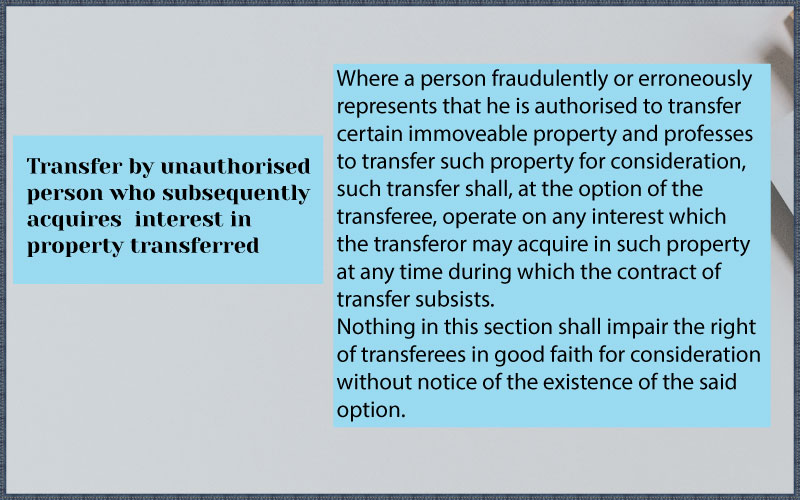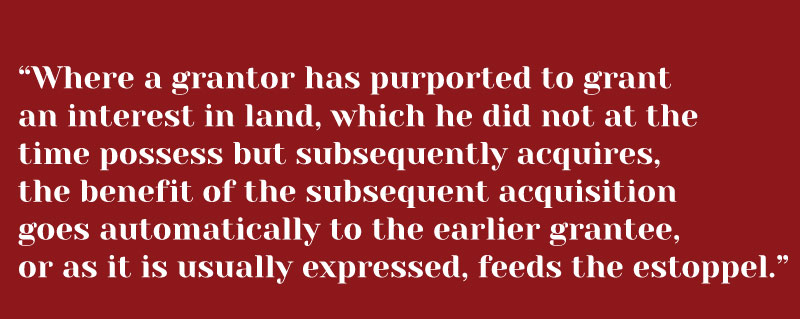In this blog, we will be discussing elaborately the doctrine of feeding the grant by estoppel, which is incorporated under section 43 of TPA, 1882. We will discuss the rules laid down in section 43, essential ingredients of section 43, the applicability and the effects of section 43 of TPA, 1882, and differences between the English principle with relevant case references.
Introduction
Section 43 of TPA, 1882 has embodied the general principle of estoppel. Doctrine of feeding the grant by estoppel is based on the principles of equity, justice and good conscience. According to section 43 of TPA, 1882 if a seller/transferor for value or consideration received, transfers a property he does not own but subsequently he acquires the title to that property, which he transferred, then the purchaser/transferee can enforce the transfer against him. This is the essence of the doctrine of feeding the grant by estoppel.
Section 43,
The Underlying Principle of Section 43 of TPA, 1882
The doctrine of feeding the grant by estoppel is originated from a maxim of equity namely, ‘Equity looks on that as done which ought to be done.’ This doctrine is derived from another Latin maxim ‘nemo dat quod non habet’ which means ‘no one can confer a better or higher right to property than what he himself possesses’. Section 43 of TPA, 1882 is an exception to this maxim.
The English doctrine of estoppel by deed as proclaimed in Rajpakshi v Femando (1920) is as follows –
The Rules Laid Down by Section 43 of TPA, 1882
The first paragraph of section 43 of TPA, 1882 promulgated the rule that, where on fraudulent or erroneous representation a person (transferor) who is unauthorized to transfer certain immovable property, proceeds to transfer the same for consideration, then till such time that the contract of transfer subsists, such transfer at the option of the transferee operates on any interest which the transferor may acquire in that property sold on fraudulent or erroneous representation of the transferor. Section 43 of TPA, 1882 is absolute and unqualified in its operation. It applies to all transfers and has no difference in its application.
Section 43 of TPA, 1882 is mainly concerned with the issue that whether the transferee has been misled by the fraudulent or erroneous representation of the transferor. Whether the transfer has acted bona fide or fraudulent in making the representation is immaterial in respect of section 43 of TPA. It is essential that the transferee was misled and s/he acted on the representation of the transferor. The subsequent acquisition by the transferor may be by inheritance or by sale.
Unlike section 41, (click here to read an article on section 41) there is no obligation cast on the transferee to make any inquiries in respect of the property and notice of encumbrances on the part of the transferee will not make the transfer of sale any less a sale free from encumbrances.
Illustration: A (husband) makes his wife (B) accept an immovable property as dower and persuaded her to marry him. The property does not belong to A rather it was his father’s property. B has married A and subsequent after A’s father’s death A has acquired the property by inheritance. Now, the wife (B) is entitled to enforce her claim against her husband under section 43 of TPA.
The second paragraph of section 43 of TPA, 1882 safeguards the rights of the second transferee in good faith and for consideration who has no notice of the option in favor of the first transferee.
Illustration: In the above-mentioned illustration if A (husband) transfers the same property to a bona fide purchaser for value and that purchaser does not have notice about the previous transfer, then the right of the subsequent purchaser will be protected under this section. If B (wife) files a suit to enforce her claim her suit will be dismissed.
Essential Ingredients of Section 43 of TPA, 1882
The followings are the essential ingredients of section 43 of TPA, 1882.
- There must be a fraudulent or erroneous representation by the transferor, having no title or imperfect title to certain immovable property;
- There must be an actual transfer of the immovable property by the transferor;
- The transfer must be for consideration;
- The transferor must have subsequent acquisition of title or interest in the said property.
Difference Between English Law and Section 43 of TPA
According to English principle, the interest or title which is subsequently acquired by the transferor passes to the transfereewithout any further act of the transferor, in contrast, under section 43 the transfer does not pass automatically but only at the option of the transferee means he has to claim it. Unlike English principle under section 43 the transferee may be defeated by a bona fide purchaser for value without notice.
Effects of Section 43 of TPA, 1882
When the transferor will subsequently acquire the title or interest in the property, at the option of the transferee the transfer will pass to the transferee for value. It is not essential that the option under this section must be exercised immediately after the right to do so is attained.
Applicability of section 43 of TPA, 1882
Section 43 of TPA, 1882 applies in respect of the following cases –
- Spes Successionis
- Leases
- Mortgages
- Exchange
Exceptions to Section 43 of TPA, 1882
Section 43 of TPA, 1882 does not apply regarding the following circumstances –
- Cases where there is no consideration
- If both parties knew the true state of facts regarding the transfer
- Execution sales
- If the transferee is not misled by the fraudulent or erroneous representation of the transferor.
- Gifts
- Transfers by law not transferable
Case References –
Muhammad Hayat v Abdul Rahim 2001 MLD 1524
The transfer contemplated under section 43 of TPA, 1882 must be a transfer which is the outcome of a fraudulent or erroneous mis-representation. Otherwise, this section will not apply.
Omar Ali Sheikh v Shamsul Alam Mridha and Others 55 DLR 257
If a person has a partial interest in a certain property and he transfers a largest interest for value then after subsequent acquisition the transferee is entitled to get the interest so acquired.
Radhasyam Gope v Aktarunnessa Begum PLR 1956 Dacca 181
Under section 43 of TPA, 1882 erroneous representation by the transferor is enough. In contrast under section 115 of the Evidence Act, the misrepresentation must be falsely made and also it must be intentional.
These were all about the doctrine of feeding the grant by estoppel. Click here to read, transfer of property all articles.
- What is Mens Rea and Actus Reus - February 13, 2024
- Case Summary of Anglo Norwegian Fisheries Case | United Kingdom V Norway - April 7, 2023
- What is a Solicitor? How to Become One - January 9, 2023



